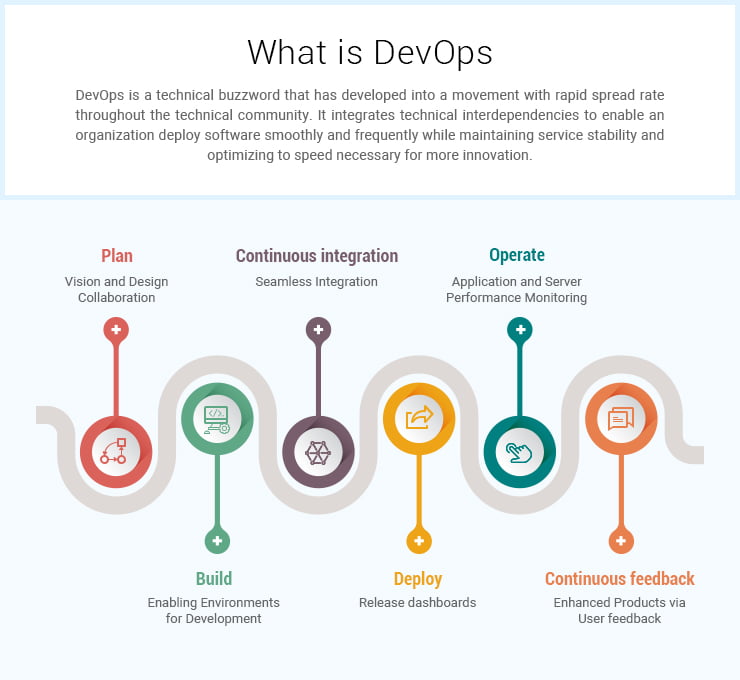
Every ambitious IT firm wants to embrace DevOps as the promise of increased software development speed as well as better business agility that is result of streamlining the interaction between development and operations. There is no shortcut way to get there. Majority of organisations tried to traverse this path with approach as if DevOps is a core technology and they all failed miserably. A successful approach is to start your journey with right people in the right DevOps roles with the right skills and a willingness to collaborate.
DevOps tools can be broken down into phases like plan, build, continuous integration, deploy, operate, and continuous feedback. Let’s explore all of them in detail.
1. Plan
It is recommended to have tools that allow development teams to plan in iterations which will help you start learning from users sooner and product can be optimized based on behalf of the feedback. One more great feature is regularly gathering user feedback and organizing it into actionable form of inputs and further prioritizing them for development teams. It will be really good if you plan to use tools that are useful in encouraging “asynchronous brainstorming” as when all will be able to share as well as comment on everything be it ideas, goals, requirements, roadmaps or documentation.
Tools for Plan Phase: Confluence, Hipchat, Jira Software
2. Build
Developers implement tools like Docker for ensuring individual development environments. When you code against virtual and disposable replicas of production the it will let you get more work done. Infrastructure as code means re-provisioning will happen quickly than repairing as well as more reliable too. It will also allow you to have a collection of variation of the development environment.
Developers usually develop modular applications that are more reliable and maintainable and this can be extended to the IT infrastructure. It can be stored inside version control as well as tested and incorporated into CI (continuous integration). Institutional knowledge is well codified in the code hence there is no need of internal documentation. This results in emerging of repeatable processes and a reliable system
Tools for Build Phase: Docker, Bamboo, Bitbucket, Chef, Docker, Puppet
3. Continuous Integration
It refers to the practice of regularly checking and testing the code with a shared repository several times in a day. This will detects issues early and will be fixed with minimum effort and time and will eventually make new features available to the user as early as possible. Tools for this phase should be capable of automatically implementing tests in development branches thereby giving you option to reach the master when branch builds are successful.
You will also receive real-time notifications directly to your chat. These tools are helpful in smoothly operating continuous integration in a multi-faceted organisation where they test rigorously without compromising the development speed
Tools for Continuous Integration Phase: Bamboo, Hipchat
4. Deploy
It is really stressful in case of a software that is about to ship and and keeping all information about changes, various tests and deployment to be kept in one place. This issue can be easily resolved with release dashboards. It is recommended to look after tools that support single dashboard well integrated with code repository and development tools. This will let you have complete visibility about branches, builds, pull requests, and deployment warnings at a single location.
Tools for Release dashboards Phase: Jira Software
5. Operate
Server monitoring and application performance monitoring are two important types of monitoring that need to be automated. A software that will listen and record data 24/7 will let you decode trends as well as overall status of the application although testing a particular API is good but limited to spot-checking. Splunk and Nagios are two most popular apps to smoothly handle these monitoring. Tools should be selected that can be easily integrated with the group chat client such that notifications alerts reach directly to your team.
Tools for Operate Phase: BigPanda, Hipchat, HostedGraphite, Nagios, New Relic, Pager Duty, Pingdom, Splunk
6. Continuous Feedback
Who else other than customers can let you decide that the product you have developed is right or still something can be done about it. Churn survey, bug reports, support tickets and NPS data will ease your task. In a DevOps complaint environment every member of the product team has access.
To user comments which will help in all the things from release planning to rigorous testing sessions. It is possible to integrate Twitter and Facebook with chat for real-time feedback. In order to gain better and focused insights from social media feedback data a social media management platform capable of pulling data on behalf of reports that have historical data.
Tools for Continuous Feedback: GetFeedback, Hipchat, Jira Service Desk, Pendo, SurveyMonkey, Hootsuite
Partner with Singsys to develop an engaging mobile, web and e-commerce application to turn your ideas into real working apps. Singsys has talented and certified pools of developers to design an affordable and attractive solutions for clients in compliance with industry standards using state of the art cutting edge technologies. Get Quote Now.
Related Posts...
DevOps tool
May 2nd, 2024
Will you be ready for the software development landscape in 2024? Expert insights on the top 15 trends – from VR collaboration to quantum computing – that will shape the future in this forward-looking Developer’s Roadmap.
Read more
Mar 26th, 2024
Cybersecurity in finance is a hot topic these days. With more and more financial transactions happening online, it’s crucial to keep our financial information safe from cyber threats. But what […]
Read more
Mar 12th, 2024
The contemporary information technology (IT) landscape is characterised by an exponential growth in data generation, primarily occurring at the network’s edge. This surge poses a challenge to traditional, centralised computing […]
Read more
